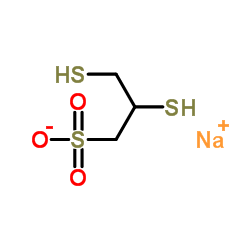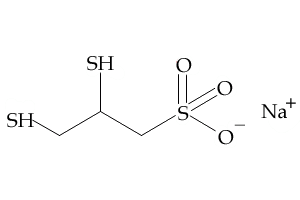2,3-二巯基丙磺酸钠,Sodium 2,3-dimercapto-1-propanesulfonate,分析标准品,98%
产品编号:Bellancom-B26586| CAS NO:4076-02-2| 分子式:C3H7NaO3S3| 分子量:210.2706
本网站销售的所有产品仅用于工业应用或者科学研究等非医疗目的,不可用于人类或动物的临床诊断或者治疗,非药用,非食用,
| 产品名称 | 2,3-二巯基丙磺酸钠 |
|---|---|
| 英文名称 | Sodium 2,3-dimercapto-1-propanesulfonate |
| CAS编号 | 4076-02-2 |
| 产品熔点 | 215 °C (dec.) |
| 精确质量 | 209.945496 |
| PSA | 143.18000 |
| LogP | 0.84060 |
| 外观性状 | 白色粉末 |
| 溶解性 | H2O: 0.1 g/mL, clear |
| 稳定性 | 常温常压下稳定,白色叶状结晶。易溶于水,不溶于乙醇。熔点235℃。半数致死量(小鼠,腹腔)5.22mmol/kg。市售商品中也有含1分子结晶水的产品。 |
| 储存条件 | 避光,通风干燥处,密封保存 |
相关文档
化学品安全说明书(MSDS)
下载MSDS质检证书(COA)
相关产品
| 危害码 (欧洲) | Xi |
|---|---|
| 风险声明 (欧洲) | R36/37/38 |
| 安全声明 (欧洲) | S24/25 |
| WGK德国 | 3 |
| RTECS号 | TZ6420000 |
| 海关编码 | 2930909090 |
Synonym:DMP Section 2 - COMPOSITION, INFORMATION ON INGREDIENTS
Risk Phrases: None Listed. Section 3 - HAZARDS IDENTIFICATION EMERGENCY OVERVIEW
Air sensitive.The toxicological properties of this material have not been fully investigated. Potential Health Effects Eye: No information regarding eye irritation and other potential effects was found. Skin: No information regarding skin irritation and other potential effects was found. Ingestion: The toxicological properties of this substance have not been fully investigated. Inhalation: The toxicological properties of this substance have not been fully investigated. Inhalation of dust may cause respiratory tract irritation. Chronic: Not available. Section 4 - FIRST AID MEASURES Eyes: Flush eyes with plenty of water for at least 15 minutes, occasionally lifting the upper and lower eyelids. Get medical aid immediately. Skin: Get medical aid immediately. Flush skin with plenty of water for at least 15 minutes while removing contaminated clothing and shoes. Ingestion: If victim is conscious and alert, give 2-4 cupfuls of milk or water. Never give anything by mouth to an unconscious person. Get medical aid immediately. Inhalation: Get medical aid immediately. Remove from exposure and move to fresh air immediately. If not breathing, give artificial respiration. If breathing is difficult, give oxygen. Notes to Physician: Section 5 - FIRE FIGHTING MEASURES General Information: As in any fire, wear a self-contained breathing apparatus in pressure-demand, MSHA/NIOSH (approved or equivalent), and full protective gear. Extinguishing Media: Use agent most appropriate to extinguish fire. Section 6 - ACCIDENTAL RELEASE MEASURES General Information: Use proper personal protective equipment as indicated in Section 8. Spills/Leaks: Sweep up or absorb material, then place into a suitable clean, dry, closed container for disposal. Avoid generating dusty conditions. Section 7 - HANDLING and STORAGE Handling: Wash thoroughly after handling. Use only in a well-ventilated area. Minimize dust generation and accumulation. Avoid contact with eyes, skin, and clothing. Avoid ingestion and inhalation. Storage: Store in a cool, dry place. Keep container closed when not in use. Section 8 - EXPOSURE CONTROLS, PERSONAL PROTECTION Engineering Controls: Use adequate ventilation to keep airborne concentrations low. Exposure Limits CAS# 4076-02-2: Personal Protective Equipment Eyes: Wear appropriate protective eyeglasses or chemical safety goggles as described by OSHA's eye and face protection regulations in 29 CFR 1910.133 or European Standard EN166. Skin: Wear appropriate protective gloves to prevent skin exposure. Clothing: Wear appropriate protective clothing to prevent skin exposure. Respirators: Follow the OSHA respirator regulations found in 29 CFR 1910.134 or European Standard EN 149. Use a NIOSH/MSHA or European Standard EN 149 approved respirator if exposure limits are exceeded or if irritation or other symptoms are experienced. Section 9 - PHYSICAL AND CHEMICAL PROPERTIES Physical State: Solid Color: white Odor: None reported. pH: 5.0 0.5 Vapor Pressure: Not available. Viscosity: Not available. Boiling Point: @ 760.00mm Hg Freezing/Melting Point: 229 deg C Autoignition Temperature: Not available. Flash Point: Not available. Explosion Limits, lower: Not available. Explosion Limits, upper: Not available. Decomposition Temperature: Solubility in water: Specific Gravity/Density: Molecular Formula: C3H7O3S3Na.H2O Molecular Weight: 228.28 Section 10 - STABILITY AND REACTIVITY Chemical Stability: Stable under normal temperatures and pressures. Conditions to Avoid: Not available. Incompatibilities with Other Materials: Strong oxidizing agents. Hazardous Decomposition Products: Carbon monoxide, oxides of sulfur, carbon dioxide, sodium oxide. Hazardous Polymerization: Has not been reported. Section 11 - TOXICOLOGICAL INFORMATION RTECS#: CAS# 4076-02-2: TZ6420000 LD50/LC50: Not available. Carcinogenicity: DI-2,3-Dimercapto-1-Propanesulfonic Acid, Sodium Salt Monohydrate - Not listed by ACGIH, IARC, or NTP. Other: See actual entry in RTECS for complete information. Section 12 - ECOLOGICAL INFORMATION Section 13 - DISPOSAL CONSIDERATIONS Dispose of in a manner consistent with federal, state, and local regulations. Section 14 - TRANSPORT INFORMATION IATA Not regulated as a hazardous material. IMO Not regulated as a hazardous material. RID/ADR Not regulated as a hazardous material. Section 15 - REGULATORY INFORMATION European/International Regulations European Labeling in Accordance with EC Directives Hazard Symbols: Not available. Risk Phrases: Safety Phrases: S 24/25 Avoid contact with skin and eyes. WGK (Water Danger/Protection) CAS# 4076-02-2: No information available. Canada None of the chemicals in this product are listed on the DSL/NDSL list. CAS# 4076-02-2 is not listed on Canada's Ingredient Disclosure List. US FEDERAL TSCA CAS# 4076-02-2 is not listed on the TSCA inventory. It is for research and development use only. SECTION 16 - ADDITIONAL INFORMATION N/A |










 浙公网安备 33010802013016号
浙公网安备 33010802013016号